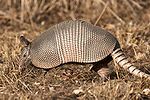Glyptodonts are an extinct clade of large, heavily armoured armadillos, reaching up to 1.5 metres (4.9 ft) in height, and maximum body masses of around...
18 KB (1,522 words) - 12:36, 14 October 2024
oυρά "tail") is an extinct genus of glyptodont from South America containing one species, D. clavicaudatus. Glyptodonts are a member of the family Chlamyphoridae...
29 KB (3,246 words) - 07:03, 18 November 2024
Glyptotherium (from Greek for 'grooved or carved beast') is a genus of glyptodont (an extinct group of large, herbivorous armadillos) in the family Chlamyphoridae...
101 KB (11,026 words) - 12:37, 14 October 2024
(gluptós) 'sculptured' and ὀδοντ-, ὀδούς (odont-, odoús) 'tooth') is a genus of glyptodont, an extinct group of large, herbivorous armadillos, that lived from the...
117 KB (12,956 words) - 12:36, 14 October 2024
capable of this. Recent genetic research has shown that the megafaunal glyptodonts (up to 1.5 metres (4.9 ft) tall with maximum body masses of around 2...
36 KB (3,519 words) - 09:22, 30 October 2024
continent, with the casualties including saber-toothed cats, ground sloths, glyptodonts, gomphotheres, the equines Hippidion and Equus neogeus, and all remaining...
211 KB (19,104 words) - 04:30, 20 November 2024
anteaters, tree sloths, and armadillos. Extinct xenarthrans include the glyptodonts, pampatheres and ground sloths. Xenarthrans originated in South America...
26 KB (2,789 words) - 01:54, 27 October 2024
pampatheriids, which reached weights of up to 200 kg (440 lb) and chlamyphorid glyptodonts, which attained masses of 2,000 kg (4,400 lb) or more. The cingulate...
20 KB (1,370 words) - 02:27, 19 November 2024
Poinar, H. N. (2016-02-22). "The phylogenetic affinities of the extinct glyptodonts" (PDF). Current Biology. 26 (4): R155–R156. doi:10.1016/j.cub.2016.01...
6 KB (272 words) - 18:14, 1 October 2024
Panochthus is an extinct genus of glyptodont, which lived in the Gran Chaco-Pampean region of Argentina (Lujan, Yupoí and Agua Blanca Formations), Brazil...
6 KB (350 words) - 08:25, 18 November 2024
Pleistocene Epoch. Many forms such as sabre-toothed cats, mammoths, mastodons, glyptodonts, etc., became extinct worldwide. Others, including horses, camels and...
21 KB (2,128 words) - 22:49, 12 November 2024
(elephant relative) Cuvieronius, as well as ground sloths, toxodontids, and glyptodonts. The concept of evolutionary anachronisms/megafaunal dispersal syndrome...
85 KB (8,921 words) - 15:44, 24 November 2024
species of soldier fly. The genus name Parapropalaehoplophorus (a fossil glyptodont, an extinct family of mammals related to armadillos) is two letters longer...
36 KB (3,233 words) - 04:46, 12 October 2024
Reconstruction of the glyptodont Doedicurus clavicaudatus, distributed in the temperate savannah and woodland of South America...
203 KB (19,900 words) - 15:53, 22 November 2024
rhinoceros-like Mixotoxodon, the gomphothere (elephant-relative) Cuvieronius, the glyptodont Glyptotherium, the llama Hemiauchenia, and the horse Equus conversidens...
185 KB (18,238 words) - 05:03, 25 November 2024
indicating that the predator successfully bit into the skull through the glyptodont's armored cephalic shield. In addition, isotopes preserved in the tooth...
109 KB (12,193 words) - 14:35, 24 November 2024
anteaters, and armadillos, as well as the extinct ground sloths and glyptodonts. Expansion in Laurasia was dominated by Boreoeutheria, which includes...
24 KB (2,372 words) - 11:08, 17 November 2024
Asterostemma is an extinct genus of glyptodont. It lived during the Middle Miocene, and its fossilized remains were discovered in South America. Like all...
3 KB (244 words) - 18:56, 3 September 2022
largest living species of armadillo (although their extinct relatives, the glyptodonts, were much larger). It lives in South America, ranging throughout as...
18 KB (1,641 words) - 03:40, 30 October 2024
Darkwing Duck, Auntie Marina in Snorks, Talula La Trane in Yo Yogi!, Glyptodont in Ice Age, Sylvia Jenkins in Free for All, Nanny in The Grim Adventures...
181 KB (15,812 words) - 16:46, 25 November 2024
Chlamyphoridae is a family of cingulate mammals. While glyptodonts have traditionally been considered stem-group cingulates outside the group that contains...
10 KB (516 words) - 00:54, 1 October 2024
dinosaurs and of some mammals, most notably the ankylosaurids and the glyptodonts, as well as meiolaniid turtles. It is thought that this was a form of...
2 KB (290 words) - 16:22, 5 August 2024
(elephant-relative) Notiomastodon, the equines Equus neogeus and Hippidion, and the glyptodonts (car-sized relatives of armadillos) Glyptodon and Doedicurus, the bear...
25 KB (2,241 words) - 10:11, 11 November 2024
The largest prehistoric animals include both vertebrate and invertebrate species. Many of them are described below, along with their typical range of size...
390 KB (40,740 words) - 22:36, 22 November 2024
septentrionalis was a comparatively small (compared to Glyptodon) species of glyptodont, extinct relatives of the modern armadillo. The mammal, identified in...
3 KB (271 words) - 08:26, 18 November 2024
while those from the Cenozoic include a giant terror bird, an armored glyptodont, the giant seabird Pelagornis sandersi, a hyaenodont, and fossil crocodilians...
16 KB (1,820 words) - 12:16, 21 November 2024
for crushing vertebrae, or for tearing open armored animals such as glyptodonts.[citation needed] However, teeth are made of unsupported enamel, and...
80 KB (8,386 words) - 20:03, 18 November 2024
member of the extinct ungulate order Litopterna Life restoration of the glyptodonts Doedicurus (front) and Glyptodon Dromornis stirtoni Asian paraceratheriid...
78 KB (8,086 words) - 02:53, 21 November 2024
List of South American animals extinct in the Holocene (section Armadillos, pampatheres, and glyptodonts (order Cingulata))
This is a list of South American animals extinct in the Holocene that covers extinctions from the Holocene epoch, a geologic epoch that began about 11...
61 KB (2,751 words) - 05:28, 22 November 2024
multituberculate mammals. Many modern mammal groups begin to appear: first glyptodonts, ground sloths, canids, peccaries, and the first eagles and hawks. Diversity...
85 KB (4,733 words) - 00:20, 3 November 2024






















